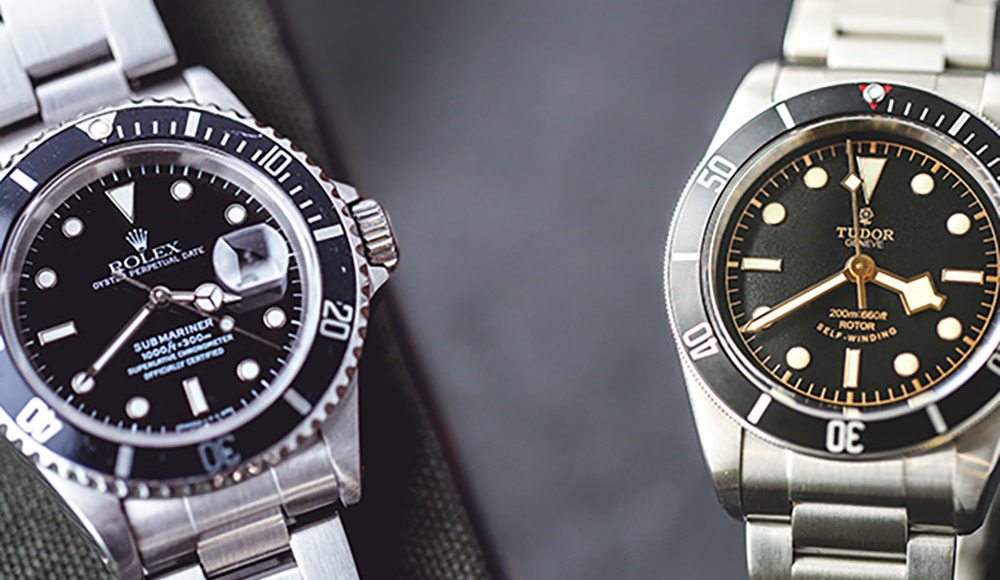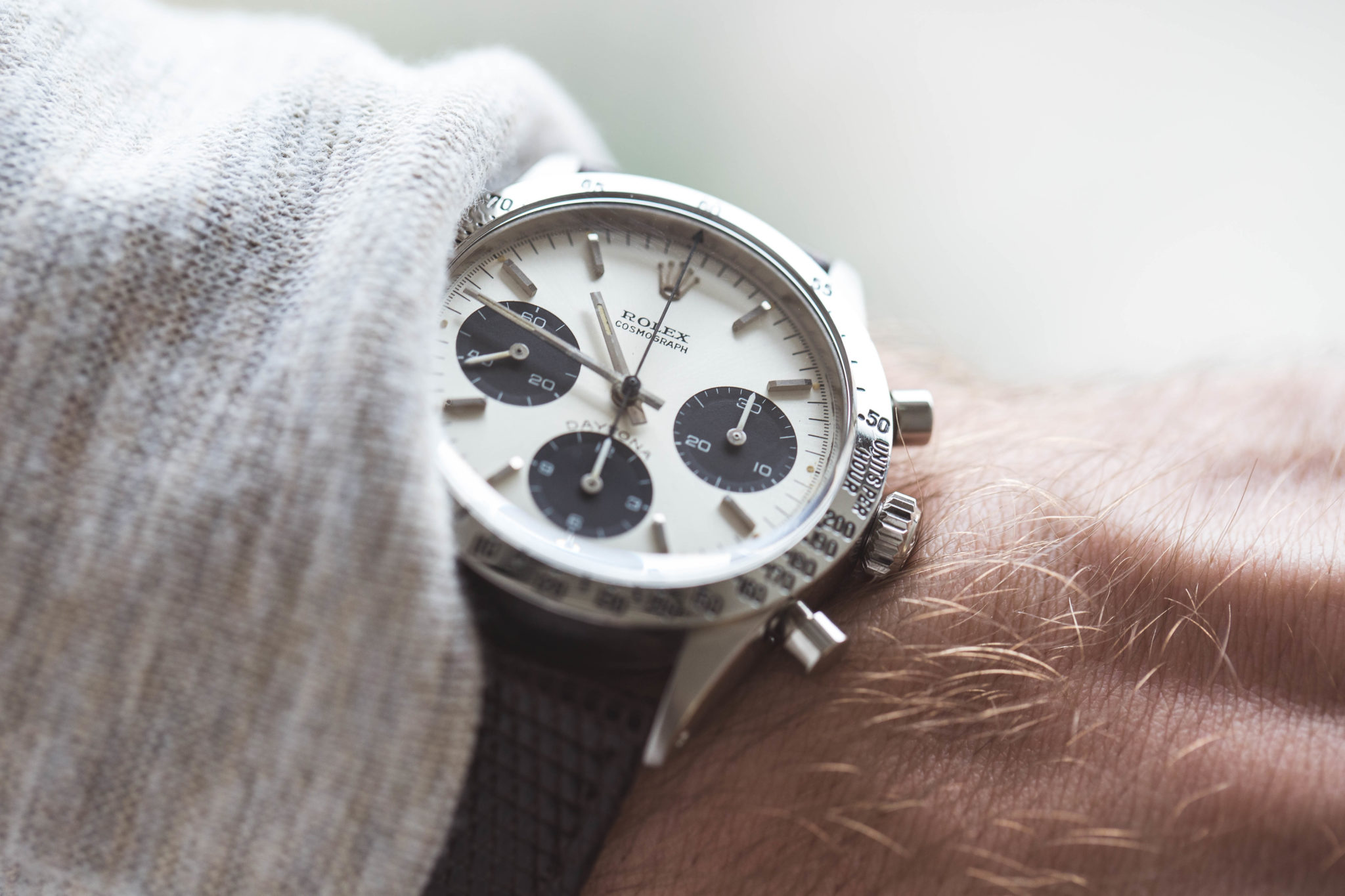Tudor vs. Rolex: Finding the One that is Right for You
The legendary Hans Wilsdorf established Rolex in 1905. When he founded Tudor just over 40 years later in 1946, fans immediately put the two brands in competition. For decades, Rolex always seemed to trump Tudor in the eyes of the watch world. However, in more recent years, Tudor has started to receive the recognition its long deserved. Still, watch lovers, like ourselves, can’t help but continue to measure the brands head to head. Here, we’ll look at Tudor vs. Rolex – the differences between Tudor and Rolex are not always obvious. Learn about the distinctions between the two brands from Crown & Caliber.
Rolex History
Wilsdorf and his brother-in-law, Alfred Davis, founded the brand in 1905. However, it didn’t officially take on the name Rolex until three years later in 1908. That year, the duo relocated from England to Switzerland and made the shift from distributing watches to designing their own. When they began to develop their own timepieces, their initial focus was on creating the most superb movements. Those efforts quickly paid off.
Just two years later in 1910, Rolex made watchmaking history. They produced the first wristwatch in the world to receive chronometer certification. That moment established Rolex as a pioneer in the industry. In the years to follow, the brand would go on to set the standard. For example, they created the first water resistant wristwatch and patented the world’s first perpetual self-winding mechanism. Over the past century, Rolex has introduced countless other innovations into the watch industry. To this day, the iconic Rolex crown serves as a symbol of superior quality, invention, and prestige.
History of Tudor Watches
Wilsdorf established Tudor in 1946 with the mission of manufacturing watches with the same integrity and principles as Rolex. However, he wanted to offer a more modest price. With the brand’s first models, he did just that. The Oyster and Oyster Prince reflected certain aspects of the Rolex style and quality. Yet, they came at a price that was more affordable and consequently accessible to a new set of customers. Into the 1950s, Tudor started to take on a life of its own.
Then, in 1954, the brand introduced one of its most notable models: the Oyster Prince Submariner. In the years to follow, Tudor would continue to develop its own signature style. However, throughout the 1970s and 80s, Tudor, like many watch brands, was impacted by the Quartz Crisis. They continued with the production of mechanical watches but dialed back their designs. In 2010, the brand rebounded with the introduction of one of their most groundbreaking models: the Heritage Chronograph. Today, Tudor has built a reputation of producing minimalistic tool watches and spectacular chronographs.
The Tudor and Rolex Relationship
For decades, there was one key difference when comparing Rolex vs. Tudor: their watch movements. Rolex uses in-house movements exclusively – a principle on which the brand was founded. On the other hand, Tudor used the more affordable Swiss ETA movements for many years. This served Tudor well in sticking with its own guiding principle of creating more accessible timepieces. However, in 2015, Tudor developed its first in-house movement. It debuted in a model called the North Flag. Soon after, Tudor added it to updated versions of the Pelagos and Heritage Black Bay models.
Still, despite Tudor’s development of their own in-house movements, the brands remain distinct in their own right. Rolex has established a reputation as one of the most well known and sought after watch brands in the world by steadfastly committing to a specific style. Their designs are timeless, classic, and a bit more conservative. On the other hand, Tudor has distinguished itself as more unique, experimental, and daring with its designs. This is evident from developments like their integrated cases to risks like using bold color schemes on their dials.
Is Tudor Owned By Rolex?
Watch industry pioneer Hans Wilsdorf is the original mastermind behind both the Rolex and Tudor brands. When he initially founded Tudor, he registered the company as a joint-stock business with all the shares owned by Rolex. However, since Wilsdorf first established the two brands, leadership has changed and they’ve grown and evolved over the years. Today, a privately held entity called the Hans Wilsdorf Foundation owns both Rolex and Tudor.
Rolex vs. Tudor: Which Should You Choose?
Bottom line: Rolex and Tudor are two of the best watch brands on the market. Whether you’re looking for a modest price point, a more avant-garde design, an iconic logo, or a certain timeless elegance, you can find a Tudor or Rolex that will serve as the perfect watch for you. If you want a more direct comparison of Rolex vs. Tudor, we’ve put two of their models head to head. Let’s take a look at the Rolex GMT vs. Tudor GMT and see how they measure up.
Rolex GMT vs. Tudor GMT
Rolex debuted the first GMT Master in 1954 in collaboration with Pan Am. The original model featured the airline’s signature red and blue colors on the two-tone bezel. Today, this bezel combination has been affectionately nicknamed the Pepsi because of its resemblance to the soda brand’s globe logo. The Pepsi variation is one of the most iconic and highly sought after among collectors. Rolex discontinued production of the original GMT Master in 1999. However, the Pepsi bezel has continued to live on in the GMT Master II. Rolex released the first red and blue Cerachrom bezel on the white gold Reference 116719 in 2014. It wasn’t until four years later that Rolex debuted the highly-anticipated stainless steel variation of the Cerachrom Pepsi. At Baselworld 2018, Rolex unveiled the Reference 126710. It features a few notable modifications from the previous iteration of the Pepsi GMT Master II. The newly designed 40mm case features reworked lugs, which give the model a sleeker appearance. This revamped case design pairs with the brand’s classic Jubilee bracelet as opposed to the original Oyster bracelet. It also houses Rolex’s in-house, Superlative Chronometer certified Caliber 3285 self-winding movement. The Caliber 3285 offers improved precision and increased resistance to shocks and magnetic fields. It also comes equipped with a 70-hour power reserve, much higher than the previous version’s 48-hour reserve.
Also at Baselworld 2018, Tudor announced they’d be following in the footsteps of their parent brand. They unveiled the Black Bay GMT with none other than a Pepsi bezel. With these two new releases, the challenge was on. The case design of the Pepsi Black Bay GMT is similar to the brand’s other Black Bay models. It measures in at 41mm, just slightly larger than Rolex’s Reference 126710. It features the brand’s trademark snowflake hands for both the hour and the additional time zone indicators. Unlike the Rolex Pepsi, the Tudor Pepsi is available with a number of band options. These include a brown leather strap with folding clasp, two-tone fabric strap with buckle, or a bracelet. The model comes standard with a riveted stainless steel bracelet, reminiscent of Tudor watches from the 1950s and 60s. Similar to its Rolex counterpart, the Pepsi Black Bay GMT houses an all-new, in-house caliber with a 70-hour power reserve. The Caliber MT5652 is a self-winding COSC certified movement.
The latest Rolex Pepsi GMT Master II in stainless steel will no doubt go down in the model’s longstanding history. Since the brand introduced the red and blue Cerachrom bezel in the white gold, fans have long awaited the addition of a stainless steel variation. However, a piece of Rolex history inevitably comes with a Rolex price tag. Tudor’s incarnation of the Pepsi in their Black Bay GMT is a worthy alternative. It boasts a similar size and specs with more band options to boot. Overall, this latest version of the GMT Master II has a bit more contemporary design, despite the classic Jubilee bracelet. On the other hand, the Tudor Black Bay GMT has more of a retro look and feel. At the end of the day, these are two admirable watches. If you have to choose between the Rolex GMT vs. Tudor GMT, it comes down to personal preference and budget.
Get More Articles Like This in Your Inbox
We're constantly creating great content like this. So, why not get it delivered directly to your inbox? By subscribing you agree to our Privacy Policy but you can unsubscribe at any time.








